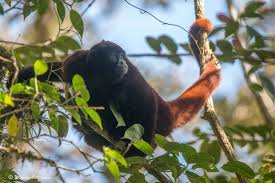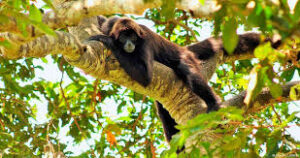The yellow-tailed woolly monkey (Oreonax flavicauda) is a species essential for biodiversity, but its survival is at serious risk due to different factors such as deforestation and hunting. For this reason, experts must work on ways to care for this species, which could be achieved through different projects focusing on obtaining a more accurate census of these specimens.
This species, also known as mochue, Peruvian choro, or quilla corote, belongs to the Atelidae family and is the only representative of the genus Oreonax. Its habitat is restricted to the cloud forests of the Andes Mountains in Peru, specifically in the departments of Amazonas and San Martín, between 1,500 and 2,300 meters above sea level.
However, it is one of the most endangered species on the planet. In the last three decades, its population has decreased by 80% due to uncontrolled hunting, habitat destruction due to road construction, and the expansion of mining projects.
“Currently, there are less than a thousand individuals left, placing this species on the brink of extinction,” warns Fanny Cornejo, a researcher at the Universidad Nacional Mayor de San Marcos and an expert in the study of this primate.

An essential role in nature
Beyond its value as a species, the yellow-tailed woolly monkey plays a crucial role in forest conservation. According to Cornejo, this primate is known as “the gardener of the forest”, as its feeding and movement allow for the dispersion of seeds, promoting ecosystem regeneration.
Its role in nature is what makes its disappearance even more concerning, as this would have devastating consequences. “If forests lose animals like this monkey, the Andean bear, or the red brocket deer, we run the risk of losing the forests themselves,” warns the researcher. According to the expert, this would affect the supply of drinking water, agriculture, and various industries, as these ecosystems provide essential resources for crops such as rice, cocoa, and coffee.
Facing this alarming situation, monitoring and protection projects are being planned to more precisely determine the status of the yellow-tailed woolly monkey population and its ecosystem. Ensuring its survival would not only benefit this species but also guarantee the stability of forests and essential water resources for millions of people.

Characteristics of the yellow-tailed woolly monkey
The yellow-tailed woolly monkey (Oreonax flavicauda) is an endemic primate of Peru characterized by its woolly fur and its tail with a yellow spot on the underside.
- Physical characteristics: It is the largest mammal in Peru, with woolly, dense, copper-colored fur. Additionally, it has white patches over the eyes, partially hidden ears with short light-colored hairs, and whitish hairs around the mouth. Their faces, in general, are pigmented dark gray. These mammals even differ between females and males by their pubic hair, the former having smaller and delicate hairs, while the males have impressive golden pubic hair.
- Habitat: these monkeys live in cloud forests, with large, tall trees in Amazonas, San Martín, Huánuco, and La Libertad. Additionally, they inhabit altitudes from 1,100 to 2,700 meters above sea level.
- Diet: this species feeds on fruits, seeds, flowers, leaves of fig trees, chontillas, plants, and insects.
- Threats: these monkeys are threatened by indiscriminate logging of their habitats, hunting for commercial purposes, and low reproduction rates with long intervals between births.
Have you visited our YouTube channel yet? Subscribe!

